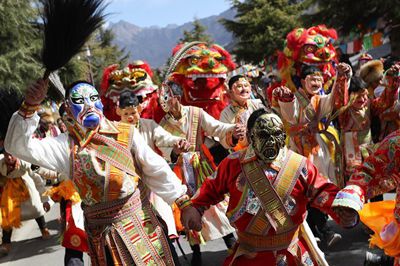|
6. Some self-exiled Tibetans claim, "We have our own national flag, army and currency. Tibet is worthy of the name of an independent country." What are the facts?
A: The "national flag" the separatists mention is the "Snow Mountain Lion Flag" -the flag of the former local Tibetan army.
By the mid-9th century, the Tubo Kingdom had collapsed. For a long time after that there were no regular troops in Tibet, and there was certainly no formal army flag. In the late 18th century the Qing Dynasty sent troops to repulse a foreign invasion in Tibet and formulated the well-known 29=articleRegulations Concerning the Administration of Tibet. The regulations called for establishing a local regular army. The 4th article stipulated, "There was no regular army in Front Tibet and Rear Tibet. When needed, an army was temporarily conscripted, thus lacking sustained fighting power, and infringing on the normal life of local inhabitants, with negative consequences. Now, with the permission of the emperor, the local regular army is to be 3,000 men strong. One thousand soldiers each will be stationed in Front Tibet and Rear Tibet, and 500 each will be stationed in Gyangze and Tingri." This 3,000-man army was the "Tibetan Army." Both regular training and command in battle called for an army flag, so the Tibetan army flag was designed. This is the history of the "Snow Mountain lion Flag" and the "army."
The currency in Tibet was a component part of China's currency system. Since the Han and Tang dynasties, the Tibetan currency has had close ties with that in the interior. In the 13th century, when Tibet formally became an administrative region of China, it used gold and silver as a means of payment, as was the practice in the interior. Tibet was one of the earliest regions to mint silver coins. In 1792, the central government of the Qing Dynasty decided to send skilled workers to Tibet and establish its own mint there. Under the supervision of the commissioner to Tibet, the first Tibetan "Zhangka" was produced in Gongbo. The following year, the Qing government formulated the 29-article Regulations Concerning the Administration in Tibet, which stipulated setting up a "coin-minting department" in Tibet. Officials appointed by the commissioner to Tibet and the Dalai lama were responsible for coin-minting affairs. All the facts show that the Tibetan currency system was decided on by the central government and the Tibetan currency minted with the approval of the Qing emperor. It was part and parcel of the national currency system. |
- Home
- News |Tibet |Exclusive |China |World |Other Tibetan-Inhabited Area |Tibet through the Eyes of Foreigners |Related News
- Documents |White Papers |Others
- Photo |Politics |Economy & Society |Culture & Religion |Human & Nature |Beautiful Tibet |Other Tibetan-Inhabited Area |Exchanges |Related
- Video |News |Documentary |Micro-Video |Entertainment
- Art
- Tourism
- In Focus
- About Tibet






